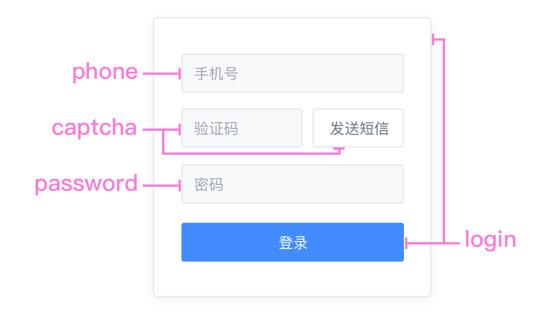您好,登录后才能下订单哦!
表单是后台项目业务中的常用组件,这次重构了登录功能以满足登录方式可配置的需求,在此记录和分享一下。
业务场景
在之前,项目只支持手机号+密码登录,前端是直接把表单写死的,后来有客户希望能支持验证码登录,有的客户还希望能有手机号+验证码+密码的登录方式…所以登录方式的灵活性需要可配置的表单支持,于是我把登录组件做了拆分。

以表单元素为粒度,分离出了手机号、密码、短信验证码这几个组件,它们内部都有自己的表单验证方法,通过组合可以快速完成登录、注册、找回密码等表单组件。高内聚低耦合、高内聚低耦合…跟着念十遍~
. ├ common ├ captcha.vue | ├ password.vue | └ phone.vue ├ login | └ index.vue ├ register | └ index.vue └ resetPassword └ index.vue
这里我们将login作为父组件,读取服务端返回的登录配置并在模板做条件渲染,登录时调用子组件内部的表单验证,最后通过Vuex拿到数据调用接口。整个可配置登录表单的逻辑就是酱子,接下来上代码。
代码
请求服务端配置数据:
/* 参数说明: * 'password': 密码登录 * 'captcha': 短信验证码登录 * 'password_or_captcha': 密码或短信登录 * 'password_with_captcha': 密码+短信登录 */ config: { login_methods: 'password' }
登录组件的核心渲染代码(pug):
.login-card .login-header h4 登录 .login-content phone(ref="phone") password( v-if="isPasswordMode" ref="password" ) captcha( v-if="isCaptchaMode" ref="captcha" ) template(v-if="isPasswordWithCaptchaMode") captcha(ref="captcha") password(ref="password") template(v-if="isPasswordOrCaptchaMode") ... el-button(@click="login") 登录
登录时需要三个步骤:表单验证、组装数据、调用接口:
async login () {
if (!this.validate()) return
const loginData = this.getLoginData()
await this.postLogin(loginData)
...
}
登录的表单验证其实是对当前登录方式中所有组件的 validate() 方法进行逻辑判断:
validate () {
const phone = this.$refs.phone.validate()
let isPass = false
if (this.isPasswordMode) {
if (this.$refs.password) isPass = this.$refs.password.validate()
}
if (this.isCaptchaMode) {
if (this.$refs.captcha) isPass = this.$refs.captcha.validate()
}
if (this.isPasswordWithCaptchaMode) ...
if (this.isPasswordOrCaptchaMode) ...
isPass = phone && isPass
return isPass
}
每个子组件都是一个完整的表单,验证也由自己完成,password组件模板:
.login-password
el-form(
:model="form"
:rules="rules"
ref="form"
@submit.native.prevent=""
)
el-form-item(prop="password")
el-input(
v-model="form.password"
type="password"
name="password"
)
W3C: When there is only one single-line text input field in a form, the user agent should accept Enter in that field as a request to submit the form.
需要注意,根据 W3C标准 , 当一个form元素中只有一个输入框时,在该输入框中按下回车会自动提交表单。通过在 <el-form> 添加 @submit.native.prevent 可以阻止这一默认行为。
password组件的表单验证:
validate () {
let res = false
this.$refs.form.validate((valid) => {
res = valid
})
return res
}
最后从Vuex里拿到所有表单数据,进行组装:
computed: {
...mapState('login', {
phone: state => state.phone,
password: state => state.password,
captcha: state => state.captcha
}),
},
methods: {
...
getLoginData () {
let mode = ''
const phone = this.phone
...
const data = { phone }
if (this.isPasswordMode) {
mode = 'password'
data.password = password
}
if (this.isCaptchaMode) {
mode = 'captcha'
data.captcha = captcha
}
if (this.isPasswordWithCaptchaMode) ...
if (this.isPasswordOrCaptchaMode) ...
data.mode = mode
return data
}
}
补充:
vue.js 全选与取消全选的实例代码
new Vue({
el: '#app',
data: {
checked: false,
checkedNames: [],
checkedArr: ["Runoob", "Taobao", "Google"]
},
methods: {
changeAllChecked: function() {
if (this.checked) {
this.checkedNames = this.checkedArr
} else {
this.checkedNames = []
}
}
},
watch: {
"checkedNames": function() {
if (this.checkedNames.length == this.checkedArr.length) {
this.checked = true
} else {
this.checked = false
}
}
}
})
免责声明:本站发布的内容(图片、视频和文字)以原创、转载和分享为主,文章观点不代表本网站立场,如果涉及侵权请联系站长邮箱:is@yisu.com进行举报,并提供相关证据,一经查实,将立刻删除涉嫌侵权内容。